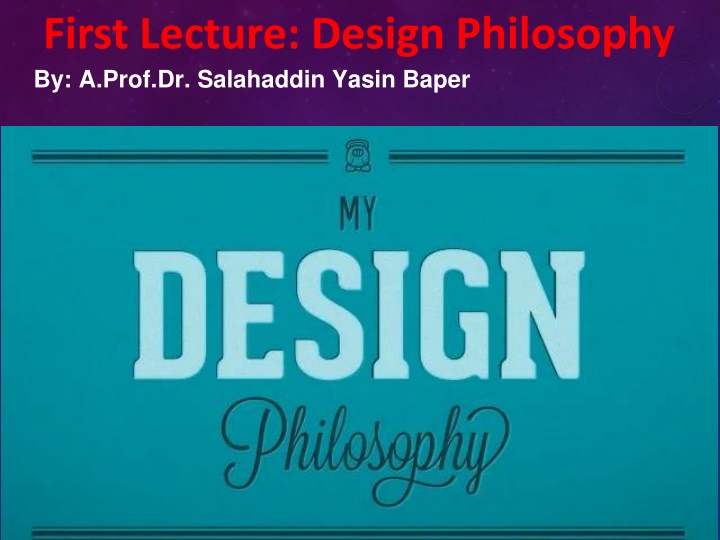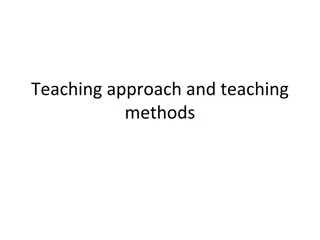
Design Philosophy and Process in Architectural Engineering
Explore the essence of design philosophy in architectural engineering, delving into the visualization, iterative process, and creative synthesis involved in achieving optimal solutions. Discover the role of the designer in decision-making, communication, and meeting original requirements through a detailed examination of key concepts like Morphology, Convergence, and Synthesis.
Download Presentation

Please find below an Image/Link to download the presentation.
The content on the website is provided AS IS for your information and personal use only. It may not be sold, licensed, or shared on other websites without obtaining consent from the author. If you encounter any issues during the download, it is possible that the publisher has removed the file from their server.
You are allowed to download the files provided on this website for personal or commercial use, subject to the condition that they are used lawfully. All files are the property of their respective owners.
The content on the website is provided AS IS for your information and personal use only. It may not be sold, licensed, or shared on other websites without obtaining consent from the author.
E N D
Presentation Transcript
First Lecture: Design Philosophy By: A.Prof.Dr. Salahaddin Yasin Baper
Design Design is the visualization and depiction of form. Design is the mental process which must intervene between the conception of a specific engineering intention and the issue of drawings to the workshop. Design is the optimum solution to the sum of the true needs of a particular set of circumstances. Design is a creative, iterative process serving a bounded objective. Architectural Engineering Design is the use of scientific principles, technical information and imagination
Designer The Designer is clearly the paragon who carries out such tasks. His/her work can be split into three areas of activity:- Decision-making regarding the physical form and dimensions of the product. Communication to the builder, mainly in the form of drawings and specifications (Graphics, Text and Computer Files). Responsibility for the achievement of the original requirements. Often the designer requirements to limit them to the possible. must guide the original
Design philosophy The following is a list of terms, aspects and concepts which reveal some of the general principles arising in design:- a) Morphology: b) Design Process: c) Stratification: There is a pattern of events and activities which, by and large, are common to all projects. Iteration to solve problems followed by feedback of information from a later stage to review decisions made earlier. As the solution to one problem emerges, a sub-stratum of lesser problems is uncovered. Solutions to these must be found before the original problem can be solved.
Design philosophy (contd.) d) Convergence: e) Decision-making: Choosing between alternatives. f) Analysis: Used to establish the characteristics of the product which is the subject of the design. This is a fundamental design tool because it forms the basis on which decisions can be made but it is not the starting point for a design. A first shot must have been made at what the whole product will be like. g) Synthesis: This is the truly creative part of design - putting together separate elements into a coherent whole. Probably this is the most characteristic part of design. Many possible solutions may be processed in search of the one correct solution.
Design philosophy (contd.) h) Creativity: i) Practicability: j) Communication: k) Dynamics: Inventiveness - obviously a highly desirable facility in a designer. What can be achieved in design is determined not only by what is technologically practicable but also by the capabilities of the design team. A design is a description of a product and the instructions for its manufacture. The quality of the end product depends critically on how well these two aspects are communicated. Design is not a static process, especially with a large and complex product. Change in requirements or solution is almost unavoidable.
Design philosophy (contd.) l) Need: m) Economic Worth: The owner of the end product must feel that it is worth the true cost of its acquisition. n) Optimization: In design terms it may not be possible to devise the optimum solution, where the optimum is determined relative to many disparate constraints and on the basis of incomplete data. The best available solution may be no more than the best compromise that can be made between conflicting qualities within the constraints. The need for the product must be clearly established before starting design work.
Design philosophy (contd.) o) Criteria: The objective and quantitative measure of how successful or how near the optimum the design is. Sometimes the criteria are subjective and qualitative the result of value judgments by those involved in the process. p) Systems Approach: When a product is part of a broader system (and very few exist in complete isolation) its design must take account of the impact of the rest of the system on it and vice versa.
Types of Marine Vehicles, Structures and Facilities Transportation General cargo ships carrying packed cargoes of various sizes, commonly known as break bulk cargo, of various types and sizes Unitized cargo carriers such as container ships, barge carriers and RORO (roll- on roll-off) vessels. Passenger vessels such as passenger ferries, cruise ships, passenger ships of various types and sizes and fast transport vessels. Ocean research vessels, coastal research vessels or fisheries research vessels, though not transport vessels, are designed like passenger vessels except that these must have a large deck area for scientific sample collection and analysis Dry bulk carriers carrying various types of bulk cargo such as ore, fertilizer, grain, etc. Liquid bulk cargo carriers such as crude oil carriers, product carriers, chemical tankers and liquefied gas carriers to carry LPG, LNG, ammonia, etc
Types of Marine Vehicles, Structures and Facilities Defence Patrol crafts patrol the coast equipped with some gunfire power. Corvettes operate in littoral waters to protect a country s assets even far away from the mainland. Frigates carry variable depth sonar, towed array, and/or torpedoes, anti- submarine torpedoes, surface-to-air/surface-to-surface missiles, landing deck and hanger to operate helicopters (equipped with sono buoys, magnetic detectors, etc.) and are also used for search-and-rescue operations. Destroyers are bigger than frigates with more weapons. Aircraft carriers are the biggest defence vessels having a single normal operating speed. Submarines are vehicles designed for going down to a depth below the surface under water and also come up as and when required.
Design philosophy (contd.) o) Criteria: The objective and quantitative measure of how successful or how near the optimum the design is. Sometimes the criteria are subjective and qualitative the result of value judgments by those involved in the process. p) Systems Approach: When a product is part of a broader system (and very few exist in complete isolation) its design must take account of the impact of the rest of the system on it and vice versa.
Design philosophy (contd.) o) Criteria: The objective and quantitative measure of how successful or how near the optimum the design is. Sometimes the criteria are subjective and qualitative the result of value judgments by those involved in the process. p) Systems Approach: When a product is part of a broader system (and very few exist in complete isolation) its design must take account of the impact of the rest of the system on it and vice versa.






